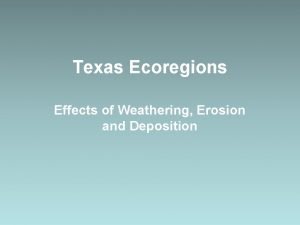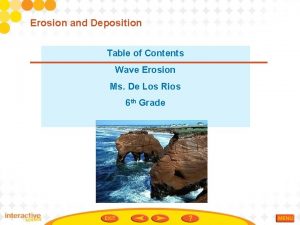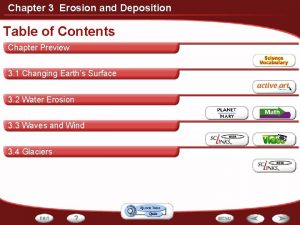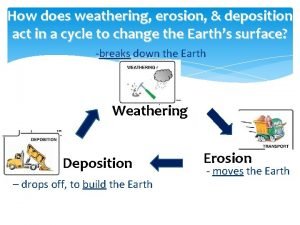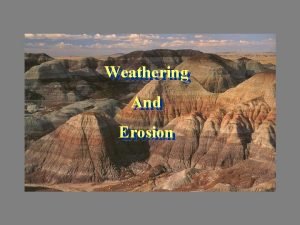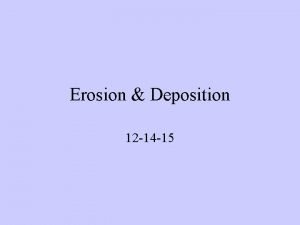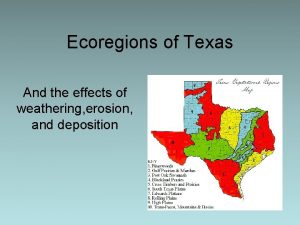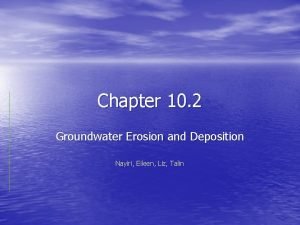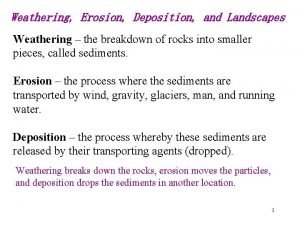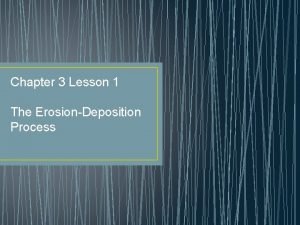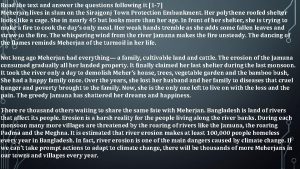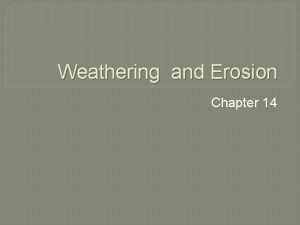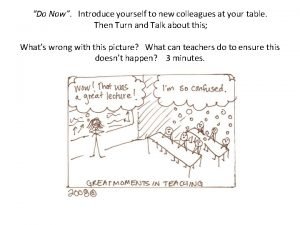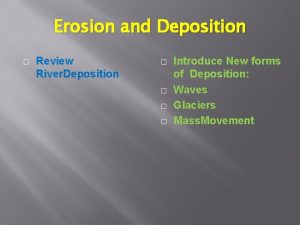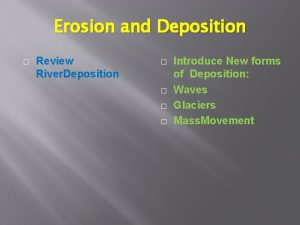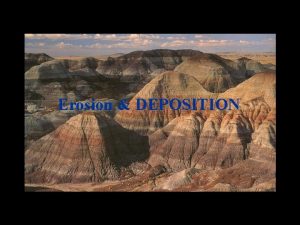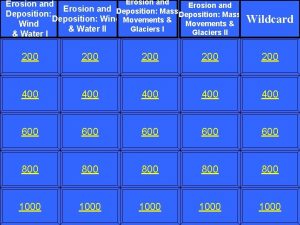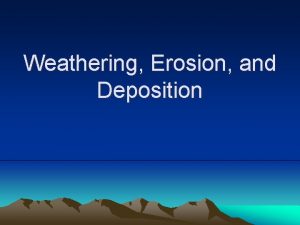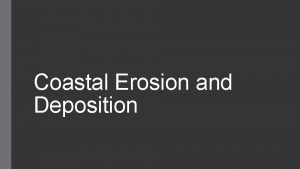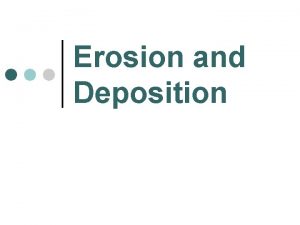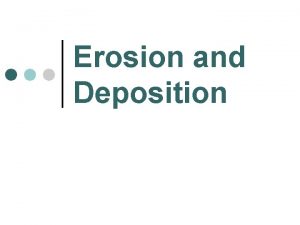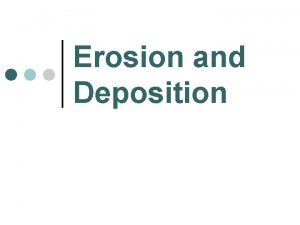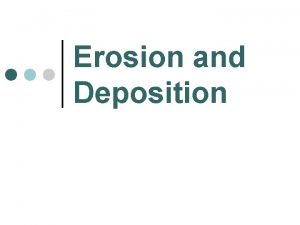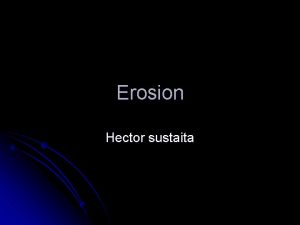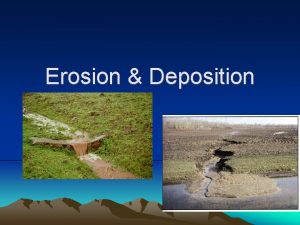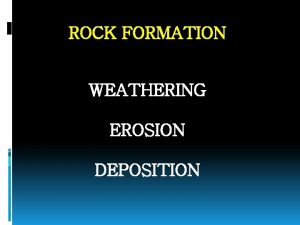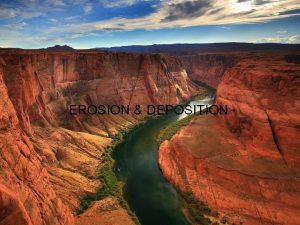Erosion and Deposition Review River Deposition Introduce New

















- Slides: 17

Erosion and Deposition � Review River. Deposition � � Introduce New forms of Deposition: Waves Glaciers Mass. Movement

Tech Terms: 7. delta – a fan shaped depositional feature, formed when a load filled stream/river slows, as it enters a larger body of water. As sediment is dropped at the mouth of the Nile River, in Egypt, a delta forms.


8. alluvial fan – a fan shaped depositional feature, formed when a fast moving mountain stream flows onto a flat plain.

9. flood plain – the area along a river that contains rich, fertile soil due to periodic overflow from a stream/river.

Wave Erosion � � Waves continuously break rock into smaller pieces. Landforms created: �Beaches �Cliffs �Sea stacks

Wave Erosion

Wind Erosion � � Wind moves sediment. Plant roots hold soil in place �Less vegetation, more erosion �Dust Bowl happened this way

3 forms of wind erosion: � Saltation is the skipping and bouncing movement of sand-sized particles in the direction the wind is blowing. � The grinding and wearing down of rock surfaces by other rock or sand particles is called abrasion. � During deflation, wind removes the top layer of fine sediment or soil and leaves behind rock fragments that are too heavy to be lifted by the wind � Abrasion commonly happens in areas where there are strong winds, loose sand, and soft rocks

Glacier Erosion � Glaciers are rivers of moving ice � Gravity moves them They pickup rocks and sediments as they move Brainpop � �

Wave Deposition � Waves carry sand, rock fragments, and shells. � This gets deposited on a shoreline. This creates a beach. Longshore currents moves parallel to a shoreline, moving sediment in a zig-zag pattern � �

3 TYPES OF WAVE DEPOSITION A sandbar is an underwater or exposed ridge of sand, gravel, or shell material. A barrier spit is an exposed sandbar that is connected to the shoreline. Cape Cod, MA is an example of a barrier spit. A barrier island is a long, narrow island usually made of sand that forms offshore parallel to t he shoreline

Wind Deposition � Wind eventually drops everything it carries � Faster it blows, more it carries. When it slows, it drops what it carries EX: _______ � �

Ice Deposition � � As a glacier melts, it drops what it carries Glacial drift - all material carried and deposited by glaciers. Glacial drift is divided into two main types, till and stratified drift.

Deposition by Gravity � Mass movement of sediments downhill

Mass Movement � � � Rapid movement: landslides, rock falls, mudflows landslide in Russia ALPS Rock fall in France mudslide in British Columbia � Slow mass movement: creep

BRAINPOP AVALANCHES
 Chad lentz
Chad lentz How does weathering impact the edwards plateau ecoregion?
How does weathering impact the edwards plateau ecoregion? Weathering in piney woods
Weathering in piney woods Rolling plains weathering
Rolling plains weathering Table
Table The term geologists use for underground water is
The term geologists use for underground water is Weathering erosion and deposition
Weathering erosion and deposition Types of weathering
Types of weathering Difference between erosion and deposition
Difference between erosion and deposition Diagram of erosion and deposition
Diagram of erosion and deposition Blackland prairie weathering erosion and deposition
Blackland prairie weathering erosion and deposition Groundwater erosion and deposition
Groundwater erosion and deposition Agent of erosion
Agent of erosion The laying down or settling of eroded material.
The laying down or settling of eroded material. Meherjan passage
Meherjan passage Meherjan lives in a slum
Meherjan lives in a slum Chapter 14 weathering and erosion review answers
Chapter 14 weathering and erosion review answers Now introduce yourself
Now introduce yourself


